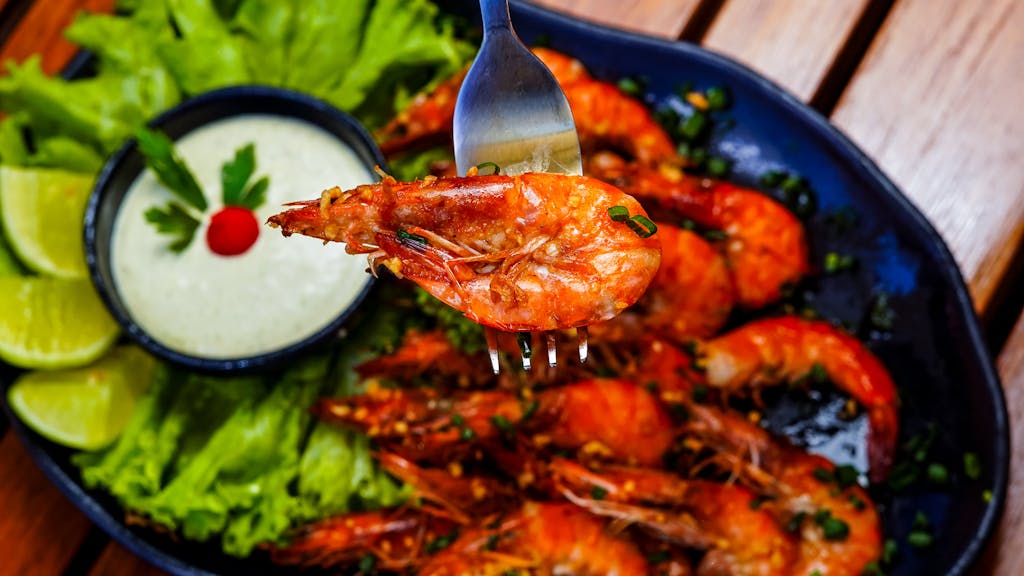Introduction — What Is Shrimp Tandoori?
Have you ever bitten into a piece of seafood that bursts with bold flavors, where every bite feels like a festival of spices wrapped in gentle smoke? That is shrimp tandoori at its finest. This dish transforms prawns into fragrant, smoky, and juicy bites that balance heat, tang, and sweetness in one go.

What makes shrimp tandoori even more appealing is its flexibility and speed. You do not need a special setup or endless hours to prepare it. Instead, it fits easily into a weeknight dinner or serves as the star of a weekend gathering. If you are someone who craves vibrant tastes but avoids complicated cooking, shrimp tandoori delivers exactly what you need.
Order Online
A Short History: Where Tandoori Comes From
The word “tandoori” has its roots in history, tracing back to the traditional clay ovens known as tandoors that were used across South Asia for centuries. These ovens relied on extremely high heat to cook meats and breads until they developed that signature smoky char while remaining tender inside.
Over time, the idea of tandoori cooking went beyond the oven itself and grew into a recognizable flavor style. Today, when people say “tandoori,” they often mean smoky, spiced, and tangy notes layered together. Still, they recreate the experience beautifully, and shrimp tandoori takes this age-old tradition and marries it with the delicate flavor of seafood.
Why Shrimp Works So Well for Tandoori
Shrimp is an excellent match for tandoori cooking because it cooks quickly, allowing the spices and marinade to work their magic without drying out the flesh. As a result, shrimp needs less preparation time than chicken or lamb yet produces equally satisfying results.
Fresh vs. Frozen Shrimp
When preparing shrimp tandoori, you can choose between fresh and frozen shrimp, and both options work well if handled properly. Fresh shrimp has a naturally vibrant flavor, but frozen shrimp often surprises people with its quality since it is usually flash-frozen right after being caught. This process locks in freshness and makes frozen shrimp a reliable choice for home cooking. To use frozen shrimp, thaw them gently in the refrigerator, pat them dry, and continue with your recipe without hesitation.
Building the Perfect Marinade
The heart of shrimp tandoori lies in the marinade. Yogurt forms the base of the marinade because it adds tang and helps tenderize the shrimp while creating a creamy coat for spices to cling to. Lemon juice or lime juice brightens the mixture and balances the richness, while garlic and ginger add warmth and depth.
A spice blend such as tandoori masala or garam masala with the addition of smoked paprika, ground coriander, cumin, turmeric, and Kashmiri chili powder builds the signature smoky-spicy character. Some cooks even add a hint of food coloring for that iconic restaurant-style red, though it remains purely optional.
Yogurt: The Secret Ingredient for Tenderness
Yogurt does more than provide tang. However, shrimp is delicate, and over-marinating can soften its flesh too much, making it mushy. A resting time between twenty to forty-five minutes is perfect. During this period, the shrimp absorbs enough flavor to make every bite shine without compromising texture.
Tandoori Masala and Substitutes
If you already have store-bought tandoori masala, your job becomes simple. Yet, if you do not, you can easily recreate the essence at home by mixing garam masala, paprika, cumin, coriander, and a pinch of turmeric. Adding smoked paprika or a small drop of liquid smoke brings in the essential smoky layer. The beauty of tandoori marinades is their adaptability, and small substitutions still deliver excellent results.
Preparing the Shrimp Before Cooking
Before marinating, it is important to prepare the shrimp correctly. You can remove the shell completely or keep the tail for presentation. If the shrimp is left wet, the marinade will not cling well, and the final flavor will not develop as fully.
Marination Time and Its Importance
Place it in the refrigerator, allowing the mixture to work its magic for at least twenty minutes but not more than forty-five minutes. Unlike chicken, which requires hours of marination, shrimp is quick to absorb flavors. Patience pays off, but excessive time in an acidic mixture may lead to poor texture.
Cooking Methods for Shrimp Tandoori
Oven Method
Using the oven offers consistency and convenience. Within four to six minutes, turning once, the shrimp will char slightly at the edges and turn opaque, creating the signature tandoori finish.
Grill Method
For the most authentic smoky effect, grilling is an excellent choice. The grill not only sears the shrimp quickly but also infuses it with a natural smoky character, especially if you add wood chips to the coals or smoker box.
Skillet or Pan-Fry Method
With a small drizzle of oil, sear the shrimp for one to two minutes per side until caramelized. This method is the fastest and still produces great results with a satisfying smoky taste.
Knowing When Shrimp Is Perfectly Cooked
The secret to great shrimp tandoori lies in timing. When shrimp curls into a tight “O,” it’s a sign of overcooking and results in a rubbery texture. Since shrimp cooks in seconds, close attention guarantees tender, juicy bites.
Achieving Smoky Flavor Without a Tandoor
Not everyone has access to a tandoor, but that does not mean you cannot enjoy the smoky flavor. Smoked paprika is an easy addition, and grilling over an open flame works well. trap the smoke.
Serving Suggestions and Pairings
Fresh cilantro and lemon wedges enhance brightness. Mint and coriander chutney balance the heat, while yogurt raita cools the palate. A simple salad of cucumber, onion, and lemon provides freshness and crunch. For drinks, crisp lagers, citrus-forward white wines, or refreshing mint-lime coolers pair beautifully. Even masala chai works as a warming after-meal beverage.
Variations and Substitutions
Shrimp tandoori is highly adaptable. If you prefer milder flavors, you can reduce chili powders or replace Kashmiri chili with paprika. On the other hand, adding green chilies or cayenne boosts the spice.
Storage, Reheating, and Food Safety
Reheat briefly in a hot skillet or under the broiler until just warmed through. Avoid repeated reheating, as shrimp loses its delicate texture quickly.
Nutrition and Dietary Notes
The marinade, depending on how much yogurt and oil you use, can vary in calories. Using low-fat yogurt and a small drizzle of oil keeps it light while maintaining flavor.
Troubleshooting Common Issues
If the shrimp feels rubbery, the problem is usually overcooking or leaving it too long in the marinade. Finally, if the smoky aroma feels missing, the dhungar method or a touch more smoked paprika can solve the issue easily.
Conclusion on Shrimp Tandoori
With just a short marination and a quick cooking method, you can bring an age-old South Asian tradition into your kitchen in a modern, accessible way. It works equally well for a family dinner or a special gathering, delivering spice, aroma, and flair to the table. Next time you crave something vibrant and memorable, prepare shrimp tandoori and watch it become the highlight of your meal.
FAQs
How long should I marinate shrimp for shrimp tandoori?
Shrimp only need about twenty to forty-five minutes of marination. Anything longer may affect the texture because of the yogurt and acid.
Can I use frozen Shrimp Tandoori ?
Yes, frozen shrimp works very well as long as it is thawed gently and dried before marination.
How can I make shrimp tandoori without a grill or oven?
A hot skillet works perfectly for searing shrimp. For smoke, smoked paprika, or the dhungar method adds excellent depth.
Is shrimp tandoori spicy?
It can be spicy, but the heat is completely adjustable. Reduce chili powders for a mild flavor or add more green chilies if you prefer stronger heat.
What are the best accompaniments for shrimp tandoori?
This dish goes perfectly with naan, basmati rice, mint-coriander chutney, refreshing raita, and light drinks like citrusy wines, crisp lagers, or mint coolers.
